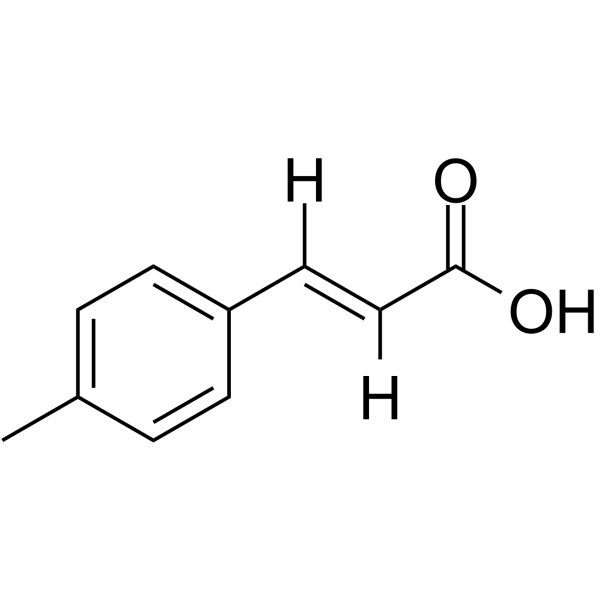Physicochemical Properties
| Molecular Formula | C10H10O2 |
| Molecular Weight | 162.19 |
| Exact Mass | 162.068 |
| CAS # | 1866-39-3 |
| PubChem CID | 731767 |
| Appearance | Typically exists as solid at room temperature |
| Density | 1.1±0.1 g/cm3 |
| Boiling Point | 300.6±11.0 °C at 760 mmHg |
| Melting Point | 196-198 °C(lit.) |
| Flash Point | 206.1±10.2 °C |
| Vapour Pressure | 0.0±0.7 mmHg at 25°C |
| Index of Refraction | 1.603 |
| LogP | 2.87 |
| Hydrogen Bond Donor Count | 1 |
| Hydrogen Bond Acceptor Count | 2 |
| Rotatable Bond Count | 2 |
| Heavy Atom Count | 12 |
| Complexity | 176 |
| Defined Atom Stereocenter Count | 0 |
| SMILES | O([H])C(/C(/[H])=C(\[H])/C1C([H])=C([H])C(C([H])([H])[H])=C([H])C=1[H])=O |
| InChi Key | RURHILYUWQEGOS-VOTSOKGWSA-N |
| InChi Code | InChI=1S/C10H10O2/c1-8-2-4-9(5-3-8)6-7-10(11)12/h2-7H,1H3,(H,11,12)/b7-6+ |
| Chemical Name | (E)-3-(4-methylphenyl)prop-2-enoic acid |
| HS Tariff Code | 2934.99.9001 |
| Storage |
Powder-20°C 3 years 4°C 2 years In solvent -80°C 6 months -20°C 1 month |
| Shipping Condition | Room temperature (This product is stable at ambient temperature for a few days during ordinary shipping and time spent in Customs) |
Biological Activity
| References | [1]. Kim JH, et, al. Cinnamic Acid Analogs as Intervention Catalysts for Overcoming Antifungal Tolerance. Molecules. 2017 Oct 21;22(10):1783. |
| Additional Infomation | 4-Methylcinnamic acid is a member of cinnamic acids. |
Solubility Data
| Solubility (In Vitro) | DMSO : 100 mg/mL (616.56 mM) |
| Solubility (In Vivo) |
Solubility in Formulation 1: 2.5 mg/mL (15.41 mM) in 10% DMSO + 40% PEG300 + 5% Tween80 + 45% Saline (add these co-solvents sequentially from left to right, and one by one), suspension solution; with sonication. For example, if 1 mL of working solution is to be prepared, you can add 100 μL of 25.0 mg/mL clear DMSO stock solution to 400 μL PEG300 and mix evenly; then add 50 μL Tween-80 to the above solution and mix evenly; then add 450 μL normal saline to adjust the volume to 1 mL. Preparation of saline: Dissolve 0.9 g of sodium chloride in 100 mL ddH₂ O to obtain a clear solution. Solubility in Formulation 2: ≥ 2.5 mg/mL (15.41 mM) (saturation unknown) in 10% DMSO + 90% (20% SBE-β-CD in Saline) (add these co-solvents sequentially from left to right, and one by one), clear solution. For example, if 1 mL of working solution is to be prepared, you can add 100 μL of 25.0 mg/mL clear DMSO stock solution to 900 μL of 20% SBE-β-CD physiological saline solution and mix evenly. Preparation of 20% SBE-β-CD in Saline (4°C,1 week): Dissolve 2 g SBE-β-CD in 10 mL saline to obtain a clear solution. (Please use freshly prepared in vivo formulations for optimal results.) |
| Preparing Stock Solutions | 1 mg | 5 mg | 10 mg | |
| 1 mM | 6.1656 mL | 30.8280 mL | 61.6561 mL | |
| 5 mM | 1.2331 mL | 6.1656 mL | 12.3312 mL | |
| 10 mM | 0.6166 mL | 3.0828 mL | 6.1656 mL |
